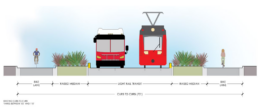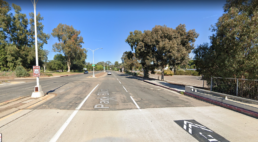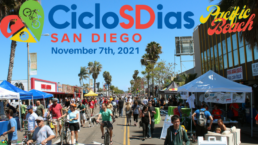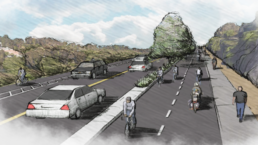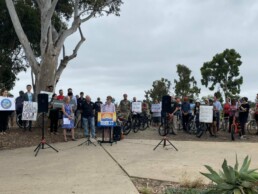BikeSD Voices: An Open Letter I Sent to the Planners behind the Hillcrest Plan Amendment
BikeSD Voices: An Open Letter I Sent to the Planners behind the Hillcrest Plan Amendment
Author: Nevo Magnezi
I recently attended the Uptown Planners Plan Hillcrest subcommittee meeting, Mobility Network Concepts, on June 30th. Or in plainspeak, planners and consultants from the city presented to community members and board members (appointed from Uptown Planners) transportation concepts that will be incorporated as part of the upcoming Community Plan Update for Hillcrest. You can learn more about this process on their website, and can see the slide deck they presented on June 30th, which I based my response on, here: Hillcrest CPG – Mobility June 2022 PDF
As someone who has been advocating for better mobility for several years, I wanted to provide new advocates an example of some of the key points I make. Admittedly, this isn’t one of my best worded emails (more like my manic midnight brain talking), but I thought it could be useful regardless.
Feel free to take my email as an inspiration to write your own with regards to mobility in Hillcrest.
Dear Ms. Mulderig, Ms. Brizuela, and Ms. Chen,
My name is Nevo Magnezi. I live in Hillcrest (have lived in both the east and southwestern portions of the plan focus area) and have been attending the Plan Hillcrest subcommittee meetings more or less since they began. I also volunteer for Bike San Diego.
I am reaching out because I’d like to provide some feedback on the most recent presentation. I am grateful for the visioning and options that the city and Chen Ryan Associates are providing and I think that whatever the outcome, it will be an improvement over the status quo.
My main concern is that planners were too quick to abandon the idea of envisioning University Ave as an active transportation and transit corridor. There are many examples around the world, the country, and, once the Gaslamp Promenade is implemented downtown, even the city, of walkable commercial corridors with very limited private automobile access, other than emergency vehicles and deliveries during specified hours.
One of my favorite examples is of the Jerusalem Light Rail, which you can see in this video: https://www.youtube.com/watch?
By recommending a vehicle network that retains general vehicle access to University Ave, I fear you will be robbing residents and visitors of the urban linear park experience that you are advocating for in other parts of the plan. The issues you identified in the presentation will certainly need to be addressed at the time of implementation, but are, for the most part, not major issues.
Your presentation claims that Option 1 would eliminate access to Fire Station No 5. Most emergency calls (65 percent) are for medical events– eliminating fast-moving traffic that cause serious injuries and fatalities and promoting a healthy lifestyle through urban design is one of the best ways that urban planners can reduce the number of emergency calls made in the first place. But even beyond that, I hypothesize that even under Option 2, emergency responders would be more likely to use the transit lanes over the general vehicle lanes anyways due to the fact that the transit lanes will, by design, should see no congestion. It seems to me very backwards that we would need to maintain high speed vehicle access so the ambulance can get to us quickly after we are run over by a vehicle that’s there because we needed vehicle only access for the ambulance. I claim to be no expert on the considerations of emergency vehicle response times in people-centric streets, but I would like to share this resource I found on the NACTO website “Best Practices: Emergency Access in Healthy Streets.”
Three of your major issues are regarding traffic circulation and congestion. It sounds like you are taking an older Level Of Service approach towards the plan area rather than a reducing Vehicle Miles Traveled approach. In the same plan, you include light and commuter rail and low stress protected bikeways. Under these schemes, people will be moved by walking, biking and transit facilities by a factor that will dwarf the number of people moving by private automobile. If transit headways or signal timing for bikeways are not considerations of the plan amendment, then why should vehicle congestion on nearby freeways be? This approach fundamentally favors the status quo and will not allow San Diego to achieve its climate action or Vision Zero goals. Caltrans is one of the agencies responsible for 55 percent of San Diego GHG emissions coming from cars and maintain right-of-way that is responsible for countless collisions that affect vulnerable road users. The fact that even basic painted bike lanes disappear when going over their right-of-way, such as University Ave over SR-163, shows how much contempt that they hold for my life and the life of anyone not in a car. Congestion on SR-163 on-ramps cannot and should not be a concern for the Hillcrest Plan.
Finally, there is the issue of deliveries. If the Gaslamp Promenade, which is being planned and funded as we speak, can already claim per their website that “the Gaslamp Promenade will be open for deliveries from 3:00 a.m. – 11:00 a.m., seven days a week,” then why are deliveries a barrier to implementation for our long-term planning just two miles away? With deliveries, and with all of these points, the Gaslamp Promenade sets an important San Diego precedent (since we seem so eager to disregard examples from any city other than our own). If a Gaslamp Promenade, then why not a Hillcrest Promenade?
My next concern is regarding the recommended Bicycle Network. As I stated during my comment, sharrows don’t do anything. This isn’t just my perspective. According to a 13 year study of a dozen cities, it is safer to not have them at all. I am grateful that planners were able to minimize them from the recommended plan in favor of other facilities, but I would also strongly encourage the amended plan not to have them at all. Instead, it would be better to designate them all as “Enhanced Class III- Bike Boulevards.” This would reinforce to those implementing the plans to not simply “slap a sharrow on it,” but rather implement true traffic calming. I think it’s also important to qualify both these and all bicycle boulevards that the street must be designed (per NACTO), to be with a target vehicle speed of less than 20mph and volume of less than 2000 ADT, or target speed of 25mph and less than 1500 ADT.
For places where you don’t intend for those speeds and volumes, such as Sixth Ave and parts of First Ave, it is negligent to suggest that no bike facilities (which is what sharrows are) are sufficient. This is an area slated for a lot of development, and connects directly to San Diego’s Crown Jewel, Balboa Park, in the case of Sixth Ave, or a massive medical complex with tens of thousands of employees, in the case of First Ave. I strongly encourage you to include Class IV facilities as part of the plan, or simply acknowledge that you intend hardly anyone to feel safe and comfortable biking there at all.
Regarding the planned Class II – bike lane facilities, I think it is also important to qualify these with the point that they are only appropriate for streets with target speeds of 25mph or less and volumes less than 6000 ADT. In the example of Robinson Ave, this would imply that the target speed would be reduced from 30mph to 25mph, if the plan were to be implemented today. Robinson Ave between Tenth Ave and Park Blvd is also a wide street with low-volumes, and can be difficult to cross as a pedestrian. I think it would be a great candidate for the extension of the Landis-style roundabout treatment that SANDAG completed east of Park Blvd, and that will connect to Robinson Ave in Hillcrest via an elevated path.
Thank you again for your work. I realize that my email is a bit more long-winded than I intended, but I would appreciate a discussion regarding any or all of the above points.
Sincerely,
Nevo Magnezi
Hillcrest Resident
Action Item: Send a Letter to ask the City of San Diego to Implement a Protected Bicycle Facility along Park Blvd in Balboa Park

Action Item: Send a Letter to ask the City of San Diego to Complete the Corridor; Implement a Protected Bicycle Facility along Park Blvd in Balboa Park
UPDATE, JANUARY 30, 2023: In early September, after months of extensive outreach, the City announced plans for protected bike lanes and separated bus lanes throughout most of Park Boulevard within Balboa Park. This is a massive win for active transportation within the City’s Crown Jewel; thank you so much to everyone who called into the planning meetings to voice your support for bikes and buses within the park! These lanes should be completed in early 2023. If you have additional questions, please contact us at talk@bikesd.org, and consider the Action Item below completed.
Since June 2021, BikeSD has been discussing with the city the opportunity to have a fully protected Class IV bicycle facility along the entire Park Boulevard corridor.
In Downtown, the city has recently implemented part of the Park Blvd section of the Downtown Mobility Plan, with the remaining segments of the class IV cycletrack already planned from K St to the I-5 bridge. From Village Place to Robinson Ave, SANDAG’s Uptown Segment 5: Park Blvd Bikeway is in the pipeline to provide improvements. And just last week, KPBS spoke with BikeSD board member Ari Criste to report on the city’s new plans to implement protected bike lanes on Park Blvd from Adams Ave to University Ave.
The last big stretch in Balboa Park is still up in the air. In November 2021, our campaign got the support of Uptown Planners, who wrote a letter in support of a class IV protected bikeway on Park Blvd in Balboa Park. The city has drafted plans for micromobility improvements to the corridor, but has not yet shared them to any community groups. We need your help to encourage the city to implement a fully-protected facility as part of the upcoming pipeline and street resurfacing project along Park Blvd in Balboa Park.
EVEN BETTER:
Write your own personal message to MayorToddGloria@sandiego.gov, StephenWhitburn@sandiego.gov, and jriveros@sandiego.gov, and please BCC: campaigns@bikesd.org. Modify this sample letter and copy/paste to your personal email app:
Dear Mayor Gloria, Councilmember Whitburn, and Transportation Director Riveros,
Thank you for the planned improvements for Park Blvd between University Ave and Adams Ave. My family and I appreciate using low-stress bike facilities to get around for our daily transportation needs.
In addition to the section of Park Blvd from University Ave to Adams Ave, we ask that the Balboa Park segment of Park Boulevard’s resurfacing efforts include a new Class IV (protected) bikeway. Park Blvd is a critical corridor between Uptown and Downtown – we are currently seeing a large volume of self-reported bicyclists using this path on a regular basis, according to open source heat maps such as Strava and Ride With GPS. Currently, micromobility users are expected to share this 2-lane roadway with parked vehicles and those driving 40+ MPH. Ideally, this road would be reduced to a single general-purpose lane traveling in either direction, a transit lane, and a protected bike facility.
Similar improvements have already been scoped out in the 2012 Bicycle Master Plan, which proposed building out a Class II (i.e. painted bike lanes) bikeway along the entirety of Park Blvd from Upas St to B St. The Balboa Park Master Plan also prescribes a bicycle trail along Park Blvd, and while a Class II bike lane would be a step in the right direction, pivoting to a Class IV protected bike lane would provide safer and more accessible infrastructure for all ages and abilities and align better with NACTO guidelines. Similar to how building more highway lanes induces greater vehicular traffic demand, building safer bicycle infrastructure induces greater bicycle traffic demand.
Besides inducing greater demand for bicyclists, safe bicycle infrastructure reduces carbon emissions within the park, slows down vehicular traffic, and improves pedestrian safety. Encouraging an increase in bicycle trips between significant commercial and residential cores (Uptown, North Park, and Downtown), as well as the numerous educational and cultural institutions along the corridor gets San Diego closer to its Climate Action Plan (CAP) goals of hitting Net Zero emissions by 2035. This upgrade is also in alignment with the 2021 Parks Master Plan which aims, among other things, to provide easy access to parks by walking, biking, and transit. Finally, by reducing speeds and protecting non-vehicle users, these improvements support the city’s Vision Zero goals.
Sincerely,
_____________
Group Ride to CicloSDias in Pacific Beach
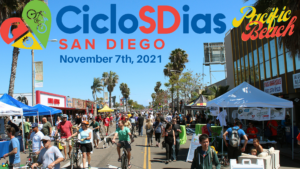
Let’s gather for a group ride from North Park to Pacific Beach for CicloSDias in PB!
Meet up at 10am at the North Park Mini Park behind the Observatory, and we’ll ride at 10:30!
We’ll make a ride that’s safe for all, and we’ll keep it casual, staying together as a group, from North Park, into University Heights, and down into Mission Valley, through Bay Park to PB.
Get to the Velodrome swap meet early (they open at 9), the ride a few blocks north to meet up!
Call to Action: Let’s Push Key Regional Bikeways Across the Finish Line! Friday 09/24 @ 9AM.
Call to Action: Let’s Push Key Regional Bikeways Across the Finish Line!
WHAT: The SANDAG Board of Directors will consider a budget amendment to accept state and federal grant funding to complete the Howard, University, and Orange Bikeways, and a section of the Inland Rail Trail. These Bikeways are part of the Regional Bike Plan Early Action Program—a proposed network of 77 miles of high-quality bikeways adopted in 2013.
BikeSD and our partner organizations need you to show the Board you support bike infrastructure! Please call into the meeting urging SANDAG to approve this budget amendment, to continue making progress on a world-class network of bike lanes.
WHEN: Friday, 9/24 @ 9:00 (virtual)
HOW:
- Attend the zoom meeting, here: https://zoom.us/j/92375925148
- Detailed instructions on the agenda, here.
- Click the ‘raise hand’ function when item 13 is called.
RECOMMENDED TALKING POINTS (Choose a few, or make them your own! Comments will likely be limited to 2 minutes.)
- Hi, my name is [NAME] with [ORGANIZATION - optional], calling in SUPPORT of today’s action to fund bikeways on Howard, University, and Orange, and the Inland Rail Trail.
- Thank you to SANDAG staff and Board for working hard to make significant progress on the Regional Bike Plan Early Action Program (EAP).
- It is clear that this funding is urgently needed. Eight years into this program, less than 14 of the 77 proposed miles are open to the public.
- However, the Bike Early Action Program needs change:
- Process Improvements: EAP projects should not take 10 years to complete. We urge you to identify ways to expedite the process of bike project delivery, and keep costs contained.
- Prioritization: Prioritize future investments in bike infrastructure in historically underinvested Communities of Concern, with the least access to safe and sustainable transportation choices.
- Expand the Network: Complete the planned EAP network as soon as possible, and then commit to expanding the network to ensure the City of San Diego’s Climate Action Plan 2035 mode shift target for biking is achieved.
- I SUPPORT this budget amendment because (pick your favorite(s)):
- Vision Zero: Cyclists’ deaths are tragic and avoidable. A safe network of bike lanes is essential to saving lives.
- Transportation Justice: Communities of color and low-income communities have the least access to safe and sustainable mobility options.
- Climate Action: Transportation accounts for more greenhouse gas emissions than any other sector by far. To stop the climate crisis, we must get people out of their fossil fuel cars and into sustainable modes of travel, ASAP.
- Clean Air: San Diego is home to some of the most polluted neighborhoods in the state, largely due to cars and trucks. To secure cleaner air, especially for environmental justice communities, we need safe, protected infrastructure so more people can choose to go by bike.
- Access to Jobs: San Diegans should not have to rely on a car to move around the region and access their daily needs. We need a bike network with better access to the region’s job centers.
- Thank you for prioritizing safe bike lanes.
Action Item: Send a Letter to Demand Immediate Improvements to the Bicycle Network in Response to the Increasing Frequency of Preventable Deaths

Action Item: Join BikeSD and seven partner organizations in demanding immediate improvements to the bicycle network in response to the increasing frequency of preventable deaths; 25 miles of protected bike lanes per year
On Monday, July 26th, BikeSD, San Diego County Bicycle Coalition, Climate Action Campaign, Circulate San DIego, and a number of other partner organizations held a Press Conference at Bird Park in North Park, close to where Laura Shinn was killed while biking to work, and demanded that bike projects stop being delayed as well as the construction of 25 miles of protected bicycle lanes in the City of San Diego every year.
BikeSD and partner organizations also wrote a policy letter detailing these demands [PDF].
You can join us in demanding immediate improvements to the bicycle network in San DIego to prevent more serious injuries and deaths, achieve our Vision Zero goal of zero deaths by 2025, as well as address our Climate Action Plan’s modeshare goals of 18% of San Diegans getting around via bike or scooter in Transit Priority Areas, by sending a letter to Mayor Todd Gloria, SANDAG Executive Director Hasan Ikhrata, as well as your San Diego city councilmember (table available at the bottom of this page with their email).
EVEN BETTER:
Write your own personal message to MayorToddGloria@sandiego.gov, hasan.ikhrata@sandag.org, as well as your city councilmember according to the table at the bottom of the page, and and please BCC: campaigns@bikesd.org. Modify this sample letter and copy/paste to your personal email app:
Mayor Todd Gloria, Executive Director Hasan Ikhrata, and City Councilmember ______,
I support the letter sent by eight community-based advocacy organizations demanding the immediate improvement of the bicycle network in San Diego in response to the recent wave of bike rider deaths. These deaths were completely avoidable and it would be unacceptable for us to maintain the status quo, which would only guarantee the continued loss of our neighbors, friends, and family members.
San Diego must quickly expand the rate in which it is building protected bicycle lanes and paths, expedite bikeways already in the pipeline such as those part of the SANDAG Early Action Plan, decrease speed limits on dangerous roads, and fully fund and finish the mobility action plan. San Diego must do these things in order to ensure that we meet our Vision Zero goals of zero traffic deaths by the year 2025, as well as our Climate Action Plan goals of 18 percent of trips being completed by bikes or scooters in transit priority areas.
Sincerely,
_____________
San Diego City Council Districts and Councilmembers
| Council District | Councilmember | Councilmember Email |
| District 1 | Joe LaCava | JoeLaCava@sandiego.gov |
| District 2 | Jennifer Campbell | JenniferCampbell@sandiego.gov |
| District 3 | Stephen Whitburn | StephenWhitburn@sandiego.gov |
| District 4 | Monica Montgomery-Steppe | MMontgomerySteppe@sandiego.gov |
| District 5 | Marni von Wilpert | MarnivonWilpert@sandiego.gov |
| District 6 | Chris Cate | ChrisCate@sandiego.gov |
| District 7 | Raul Campillo | RaulCampillo@sandiego.gov |
| District 8 | Vivian Moreno | VivianMoreno@sandiego.gov |
| District 9 | Sean Elo-Rivera | SeanEloRivera@sandiego.gov |
Use this map to find out which city council district you are in.

